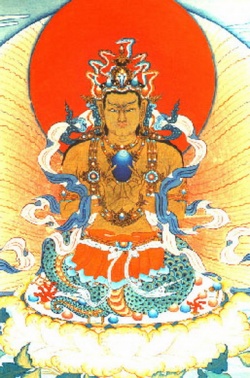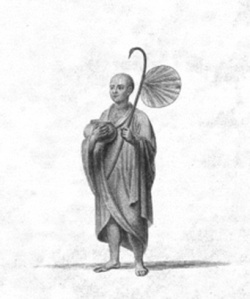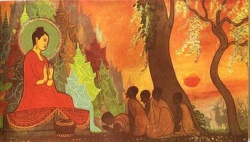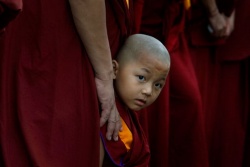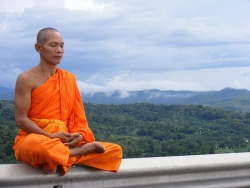Two ways of looking at emptiness
HINDU CONTEXT
In the Hindu context of Awakening,all illusion is removed so that the Brahman can be revealed. The life that we live and the phenomenon that we perceive is Samsara, the illusion. Brahman is the only absolute truth and is the firm base of Samsara. but, only when the
illusion vanishes is the Non-dual Brahman evident and the human creature free of the bondage of illusion.
BUDA DHARMA CONTEXT
In Buda dharma, illusion is not eliminated, it co-exists with the truth of the primordial state and its understanding is a part of the knowledge of Awakening. Thus a "wisdom consciousness" or knowledge, is the true consciousness of the Ignorance of Samsara, the
Stained consciousness.. Samsara is not an illusion which will vanish so that only the Brahman will remain. In Buddh Dharma, Samsara is interdependently arisen (pratityasamutpann), as illusions. So Samsara is always present, but seen as illusion, and as such has no
power to entrap the human mind in the three poisons of confusion, greed, and aversion (skt. svabhava siddha).
Advaya and Advaita in Buda Dharma
Both Advaita knowledge and Advaya are called "non-dual", but they are two different things.
Non-dual (advaita) in the Hindu context means "non-existence of the second "(divitiyam nasti). There is no second substance except the Brahman, that is the only thing that exists 'eka vastu vada'.
In Buddha Dharma we use 'advaya' which means "not two'", thus there is freedom from both extremes. (skt. dvaya anta mukta).
Now this becomes very important in Buda Dharma, because the two extremes are:
1. The tendency to see things as really existing (samaropa)
2. The tendency to see things as non-existing (apavada).
Advaya is not the "One and only thing"... the unity of all thngs into Brahmin, which is an Asolute Duality. Instead it is a description of the relation and union between Samsara and the Natural human state.. That is why the Samsara which is like an illusion which
transforms into Advaya Gyana. Knowledge of the Unity of all things beyond words.
Thus Alaya is the base and Advaya Gnana is the Wisdom of the Samsara world. What we do in Buddha dharma is simply remove the stained aspects and reveal Advaya Gyana.
Now there are two traditions of 'advaya' in Buddhism.
1. One is called the Extensive Tradition (skt. Vaipulay parampara) of Asanga-Vasubandyhu based on the 'Five Works' of Maitreya which emphasizes subject-object (skt. grahaka-grahya) duality. The two neither merge into one whole nor does the grasper (subject) destroy
the illusion and and remain purified.
This pair are clearly seen as unteneable and that only vacuity can exist. This was the position taken by Dingnaga-Dharmakirti.
This in Chan Ssu Lun we liken to the condition of an Arahat who has eliminated Identity, but must continue with the vigalence and practices to maintain Mara at bay.
2. Is the Profound Tradition (skt. gambhira parampara). it started with started with Nagarajuna and was passed down through Kanadeva and later Vasubandhu, eventually leading to the direct path CHAN and in other paths by Aryadeva, among them the famous Shantideva and
Atisha, eventually leading to the direct Path of MAHAMUDRA and play a part in almost all of the gradual paths.
This is the position of Chan Ssu Lun.
That is the position of Mahamudra.
But essentially there is a difference between Chan and mahamudra and the Gradual streams. These two direct Contemplation precisely and DIRECTLY at the point of neither extreme.
Do you remember those extremes:
1. The tendency to see things as really existing (samaropa)
2. The tendency to see things as non-existing (apavada).
This will be important to see when we continue and begin the expositions on the meditations themselves.
Any Buddhist ideas and practices must be based on one of these hermeneutics (.Vaipulay parampara or gambhira parampara). One cannot give shallow interpretations of the sutras o sastras. Any interpretation must belong to one of these methods. Otherwise it becomes
one's egoistic and distorted idea of what the texts are teaching.
That is our argumant also against Buddhism today. Buddhist texts are misinterpreted and rites and ceremonies without a philisophicl base enter into most teachings and superstition or parrot like behaviour takes root in the minds which are confused or greedy..
Should meditators be interested in such theoretical positions? Are theories just intellectual rambling. Others say the truth can be accomplished buy just meditation and others by a pure Wisdom path.
Those are false ideas. Kanadeva, Asanga, Vasubandhu, Nagarjuna, Shantideve and Atisha who generated these ideas are among the greatest Buddhist masters in history but they used both theory and meditational practice.
They believed that it was necessary to acquire the correct philosophical base in order to practice Buda dharma meditation. That is the position that we take.
